Brent Marchant's Blog, page 96
February 25, 2018
An Irreverent Look at the Oscars
Looking for an irreverent look at this year’s likely Oscar winners? Tune in to the latest episode of TheCoffeeCast featuring host Tom Cheevers and yours truly, available by clicking here. SENSITIVE VIEWERS TAKE NOTE: EXPLICIT LANGUAGE WARNING!

The post An Irreverent Look at the Oscars appeared first on Brent Marchant.
February 23, 2018
Who Will Win This Year’s Oscars?
It’s that time of year again – time for my predictions of the winners at the annual Academy Awards. Most of the major honors appear fairly clear-cut at this point, with little in doubt. Nevertheless, with that said, here are my picks for who will likely take home statues this year:
Best Actor
The Field: Timothée Chalamet, “Call Me By Your Name”; Daniel Day-Lewis, “Phantom Thread”; Daniel Kaluuya, “Get Out”; Gary Oldman, “Darkest Hour”; Denzel Washington, “Roman J. Israel, Esq.”
Who Will Likely Win: Gary Oldman. This is a virtual lock. Having won almost everything leading up to the Oscars, this is Oldman’s award to lose.
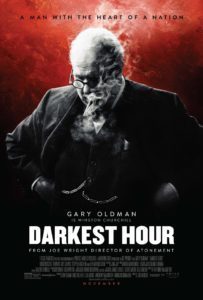
Who Should Win (Based on the Nominees): Gary Oldman. Despite capable performances by Daniel Day-Lewis and Daniel Kaluuya, there’s really no one else in this category that can hold a candle to Oldman’s stellar portrayal of the legendary British prime minister. This is a case of the right performer winning for the right role. It’s also good to see well-deserved recognition coming the way of someone who’s long overdue for receiving it.
Who Should Win (Based on All Eligible Candidates): Gary Oldman. Once again, Oldman’s performance is head and shoulders above virtually all of the 2017 contenders. From the first time I saw the trailer for this film, I knew Oldman would be the winner of the best actor award and deservedly so. To be sure, there were some other performers who should have been nominated in place of those who were so honored, but none of them can top Oldman in this category.
Possible Dark Horse: Anyone who isn’t Gary Oldman. Among the contenders, the leader here would probably be Daniel Day-Lewis, who’s announced his retirement from acting and giving his swan song performance in “Phantom Thread.” In light of that, there’s a possibility (albeit slight) that Academy voters might want to honor him with “one for the road,” an honor that would make him only the second performer to win four acting Oscars and the only one ever to do so in the lead performance category. However, don’t bank on this outcome, as it’s a highly remote possibility.
Also-Rans: Anyone who isn’t Gary Oldman.
Who Should Have Been Left Out: Timothée Chalamet and Denzel Washington. In all honesty, this is a surprisingly weak field of nominees overall. Oldman definitely belongs, and good arguments can be made for including Day-Lewis and Kaluuya. However, Chalamet is vastly overrated, and Washington, though capable, has definitely done better. These slots should have been opened up to more deserving performers.
Who Else Should Have Been Considered: It’s ironic that Academy voters have come up with such a weak field of nominees in light of the strength of the universe of potential contenders in 2017. There were many fine lead acting performances, some of whom might have even given Oldman a run for his money, who were completely ignored and left out of the dance. Principal among them, in my opinion, are the three male leads in “Last Flag Flying,” Bryan Cranston, Laurence Fishburne and Steve Carell, all of whom are deserving and all of whom were noticeably absent from nominee lists in all of this year’s awards competitions (perhaps they canceled one another out?). Another notably missing nominee is James Franco, Golden Globe Award winner for best actor in a comedy for “The Disaster Artist,” but his absence may be attributable to off-screen allegations that have been leveled against him since his Globe victory. Beyond these contenders, others who worthy of merit include John Cho for “Columbus,” a performance in which the actor shows previously unseen depth; Timothy Spall and Colm Meaney, both for “The Journey,” performances whose merits may have been undermined by undue criticism of the film’s narrative; Harry Dean Stanton for “Lucky,” a career-topping performance for an undervalued actor in his final role; Michael Keaton for “The Founder,” the kind of role this actor was born to play; and Ethan Hawke for “Maudie,” Sam Elliott for “The Hero” and Jamie Bell for “Film Stars Don’t Die in Liverpool,” all underrated performances in underrated films that, save for a BAFTA Award nomination for Bell, have all gone unrecognized.
Best Actress
The Field: Sally Hawkins, “The Shape of Water”; Frances McDormand, “Three Billboards Outside Ebbing, Missouri”; Margot Robbie, “I, Tonya”; Saoirse Ronan, “Lady Bird”; Meryl Streep, “The Post”
Who Will Likely Win: Frances McDormand. This is a virtual lock. Having won almost everything leading up to the Oscars, this is McDormand’s award to lose.
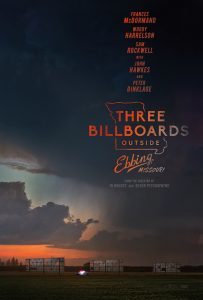
Who Should Win (Based on the Nominees): Frances McDormand, though strong cases could be made for Sally Hawkins and Margot Robbie. Even though neither of these contenders likely stands much of a chance, wins by either of them could certainly be justified. Were it not for the overwhelming strength of the McDormand juggernaut, they might be in the running (but don’t expect that to happen).
Who Should Win (Based on All Eligible Candidates): Frances McDormand, though, again, as discussed above, equally strong arguments could be made for Hawkins and Robbie.
Possible Dark Horse: Saoirse Ronan. Having won the Golden Globe Award for best actress in a comedy, there is a slight possibility Ronan could pull off an upset, though this is probably a long shot at best at this point.
Also-Rans: Essentially anyone who isn’t Frances McDormand.
Who Should Have Been Left Out: Meryl Streep and Saoirse Ronan.
Regarding Streep: As I’ve written in the past, I’m a huge fan of the actress, who is arguably today’s best living leading lady. Even a weak performance by Streep’s standards is usually far better than the best most actresses are capable of. However, given that she can’t realistically be named the winner for each of her portrayals, it seems equally unrealistic to keep nominating her – almost annually – for performances for which it’s obvious she’s not going to win. Admittedly, this probably means unfairly subjecting her to a higher standard than that accorded her peers. However, automatically nominating her even when she’s merely adequate denies other actresses an opportunity for nominations and valuable exposure. Streep’s performance in “The Post,” though capable, certainly meets these criteria. In my opinion, this is an instance where Academy voters should have resisted the temptation to give her yet another knee-jerk nomination to open up the field to others more deserving of such an accolade.
Regarding Ronan: In my opinion, this was an egregious case of miscasting. Ronan is clearly too old to be playing a teenager (especially after having previously played a twenty-something in “Brooklyn” (2015)). What’s more, I believe that the performance itself is highly overrated. Perhaps that’s because the material she was working with wasn’t that strong to begin with, and, even though she did her best to cover that, I still didn’t see what all the fuss was about where her performance was concerned. She, too, should have been excused from this category in favor of others more deserving.
Who Else Should Have Been Considered: A number of veteran nominees and several newcomers certainly merited consideration. Worthy candidates among those having received awards and/or nominations previously include Judi Dench for “Victoria and Abdul,” Emma Stone for “Battle of the Sexes,” Annette Bening for “Film Stars Don’t Die in Liverpool,” Salma Hayek for “Beatriz at Dinner,” and Jessica Chastain for both “Molly’s Game” and “The Zookeeper’s Wife,” all of whom turned in fine performances in roles they seemed destined to play. Another acting veteran worthy of consideration – one who has somehow managed to never receive an Oscar nomination – is Lois Smith for “Marjorie Prime,” an outstanding portrayal that is perhaps the best of her career. As for newcomers, there’s child star Mckenna Grace, who turned in a superb performance in “Gifted,” Aubrey Plaza, whose scathingly hilarious turn in “Ingrid Goes West” deserves more attention than it has received, and Diane Kruger, who gives an impressive lead performance in the German thriller “In the Fade.” Lastly, there’s Sally Hawkins’s other stellar 2017 performance in the independent Canadian drama, “Maudie,” in which the actress turns in a portrayal on par with the role for which she was nominated.
Best Supporting Actor
The Field: Willem Dafoe, “The Florida Project”; Woody Harrelson, “Three Billboards Outside Ebbing, Missouri”; Richard Jenkins, “The Shape of Water”; Christopher Plummer, “All the Money in the World”; Sam Rockwell, “Three Billboards Outside Ebbing, Missouri”
Who Will Likely Win: Sam Rockwell. This is a virtual lock. Having won almost everything leading up to the Oscars, this is Rockwell’s award to lose.

Who Should Win (Based on the Nominees): Sam Rockwell, though a strong case could be made for Christopher Plummer. However, as worthy as Plummer’s performance was (turned in under unusual extenuating circumstances at that), it’s unlikely he’ll be able to secure a victory, partly from having won not long ago for his portrayal in “Beginners” (2010) but also due to the strength of Rockwell’s momentum.
Who Should Win (Based on All Eligible Candidates): Sam Rockwell, though, again, a strong case could be made for Christopher Plummer. Given the prolific nature of the octogenarian’s career in recent years – not to mention the strength of his performances – it’s obvious the Academy would like to honor Plummer for a portrayal truly worthy of the award (something that can’t necessarily be said for his comparatively lightweight role in “Beginners”), and his performance in “All the Money in the World” is the kind of part that rises to that standard. Unfortunately, as strong as his performance is, it’s unlikely that it has enough juice behind it to unseat Rockwell as the favorite.
Possible Dark Horses: Willem Dafoe and Christopher Plummer. Having entered awards season as the leading contender in this category, Dafoe seemed a shoo-in, especially after capturing top honors from the National Board of Review. However, given Rockwell’s success in competitions since then, it would appear Dafoe’s star has faded, and it seems unlikely that he’ll get that momentum back; expect him to remain seated in the audience on Oscar night. As for Plummer, see the discussion above.
Also-Rans: Richard Jenkins and Woody Harrelson. Despite the strength of their performances, Jenkins and Harrelson should consider their nominations their awards.
Who Should Have Been Left Out: This is a good field, and it’s hard to imagine any of the nominees being left out. However, as noted below, there are many other supporting actors who could have easily qualified for nomination in this category with no disrespect toward any of the candidates who made the cut.
Who Else Should Have Been Considered: 2017 was a very strong year for supporting actors, and many contenders easily could have qualified. Christopher Plummer, for example, who actually did earn a nomination, easily could have qualified on the basis of two additional performances in “The Man Who Invented Christmas” and “The Exception” (even though the films themselves weren’t overly compelling). On top of that, others who merited consideration include the comedic performances of Steve Carell for “Battle of the Sexes,” Ray Romano for “The Big Sick,” Daniel Craig for “Logan Lucky,” Paul Walter Hauser for “I, Tonya,” Eddie Izzard for “Victoria and Abdul,” and Jeff Goldblum and Tom Hiddleston for “Thor: Ragnarok”; the dramatic turns of John Lithgow for “Beatriz at Dinner,” Daniel Brühl for “The Zookeeper’s Wife,” Will Poulter for “Detroit,” Benny Safdie for “Good Time,” Bob Odenkirk and Bruce Greenwood for “The Post,” and Idris Elba, Michael Cera and Bill Camp, all for “Molly’s Game”; and the sci-fi performances of Harrison Ford and Jared Leto for “Blade Runner 2049.”
Best Supporting Actress
The Field: Mary J. Blige, “Mudbound”; Allison Janney, “I, Tonya”; Lesley Manville, “Phantom Thread”; Laurie Metcalf, “Lady Bird”; Octavia Spencer, “The Shape of Water”
Who Will Likely Win: Allison Janney. This is a virtual lock. Having won almost everything leading up to the Oscars, this is Janney’s award to lose.

Who Should Win (Based on the Nominees): Allison Janney. Though she has capable competition from all of the other nominees in this category, her performance still rises to the top.
Who Should Win (Based on All Eligible Candidates): Allison Janney. Like Gary Oldman in the lead actor category, this is another case of the right performer winning for the right role, with well-deserved recognition coming her way at last.
Possible Dark Horse: Laurie Metcalf. Having entered awards season as the leading contender in this category, Metcalf seemed a shoo-in, especially after capturing top honors from the National Board of Review. However, given Janney’s success in competitions since then, it would appear Metcalf’s star has faded, and it seems unlikely that she’ll get that momentum back; expect her to remain seated in the audience on Oscar night.
Also-Rans: Mary J. Blige, Lesley Manville and Octavia Spencer. While it was gratifying to see these actresses receive their nominations (especially Manville, who had been largely overlooked in prior competitions), they should consider this recognition their awards. Having won not long ago for “The Help” (2011), Spencer is unlikely to capture another statue so soon. And, as for Blige and Manville, they should look upon their nominations as down payments toward future recognition, as both are strong contenders to take home awards at some point. In any event, despite the strength of their portrayals, it’s virtually impossible that they’ll be able to overtake Janney.
Who Should Have Been Left Out: This is a good field, and it’s hard to imagine any of the nominees being left out. However, as noted below, there were a number of other qualified supporting actresses who could have easily qualified for nomination with no disrespect toward any of the candidates who made the cut.
Who Else Should Have Been Considered: With the exception of Holly Hunter in “The Big Sick,” the supporting actresses who I believe deserved consideration appeared in roles that, for whatever reason, didn’t generate much buzz. Nonetheless, these performances were noteworthy and, in my opinion, merited attention. The contenders include Sarah Silverman for “Battle of the Sexes,” Dafne Keen for “Logan,” Lindsay Duncan for “Gifted,” Brooklynn Prince for “The Florida Project,” Kristin Scott Thomas for “Darkest Hour” and Elisabeth Moss for “The Square.” Even a few offbeat roles that might prompt others to ask “What is Brent thinking?” were worthy of consideration, including Robin Wright for “Blade Runner 2049,” Cate Blanchett for “Thor: Ragnarok,” Dolly Wells for “I Do…Until I Don’t” and (dare I say it) Michelle Pfeiffer for “Mother!” (despite the overall detestability of this production).
Best Director
The Field: Paul Thomas Anderson, “Phantom Thread”; Guillermo del Toro, “The Shape of Water”; Greta Gerwig, “Lady Bird”; Christopher Nolan, “Dunkirk”; Jordan Peele, “Get Out”
Who Will Likely Win: Guillermo del Toro. This is a virtual lock. Having won almost everything leading up to the Oscars, this is del Toro’s award to lose.

Who Should Win (Based on the Nominees): Guillermo del Toro, though credible arguments could be made for Christopher Nolan and Jordan Peele. Even though neither of these contenders likely stands much of a chance, wins by either of them could certainly be justified. Were it not for the overwhelming strength of the del Toro juggernaut, they might be in the running (but don’t expect that to happen).
Who Should Win (Based on All Eligible Candidates): Guillermo del Toro, though, again, credible arguments could be made for Christopher Nolan and Jordan Peele. Nolan knocked it out of the park with “Dunkirk,” and Peele made an impressive debut with “Get Out” (it’s remarkable that a film released so early in the year was even remembered at awards time, let alone that it received the recognition it has, and that’s largely attributable to Peele’s excellent directorial work).
Possible Dark Horses: Greta Gerwig. The “Lady Bird” director has become something of a Hollywood darling in recent months, and, as the only woman nominated in the category in a year in which women’s empowerment is being celebrated, there’s a chance (albeit an outside one) that Gerwig might be able to pull an upset (though don’t expect it).
Also-Rans: Paul Thomas Anderson. Though he has crafted a gorgeously photographed, well-acted, beautifully scored, exquisitely costumed and produced film, the director has also created a picture with a story about which it’s difficult to figure out why anyone should care. “Phantom Thread” is one of 2017’s most overrated offerings, and, as master of the helm, Anderson is responsible for the final product – one that doesn’t live up to its hype. If the indifference that many audience members have shown for this film is reflected in the voting, Anderson will be watching someone else walk up to the stage to collect his or her hardware.
Who Should Have Been Left Out: Greta Gerwig and Paul Thomas Anderson.
Regarding Gerwig: While “Lady Bird” has its moments, much of it reminds me of any number of Gerwig projects in which she appears before the camera; the only difference this time is that she’s behind it, directing others to do what she usually does herself. To me, that’s not enough to land her on the list of contenders. In my view, she’s in need of finding new direction (pun intended).
Regarding Anderson: See above.
Who Else Should Have Been Considered: While it’s refreshing to see some new faces being honored in this category, there’s room for others, and many of 2017’s best pictures were directed by little-known or unsung talents. Among those who merited consideration for this honor include relative newcomers/unknowns James Mangold for “Logan,” Matt Spicer for “Ingrid Goes West,” Kogonada for “Columbus,” Dave McCary for “Brigsby Bear,” Martin McDonagh for “Three Billboards Outside Ebbing, Missouri,” Craig Gillespie for “I, Tonya,” Michael Showalter for “The Big Sick,” John Carroll Lynch for “Lucky,” Michael Almereyda for “Marjorie Prime,” Miguel Arteta for “Beatriz at Dinner,” Paul McGuigan for “Film Stars Don’t Die in Liverpool,” Brett Haley for “The Hero,” and Jonathan Dayton and Valerie Faris for “Battle of the Sexes,” as well as veteran filmmaker Richard Linklater for “Last Flag Flying.”
Best Picture
The Field: “Call Me By Your Name,” “Darkest Hour,” “Dunkirk,” “Get Out,” “Lady Bird,” “Phantom Thread,” “The Post,” “The Shape of Water, “Three Billboards Outside Ebbing, Missouri”
What Will Likely Win: This is the most difficult category to handicap, with much depending on the mood that Academy voters are in at the time they cast their ballots. I basically see this as a two-horse race between “Three Billboards Outside Ebbing, Missouri” and “The Shape of Water,” with a slight edge to “Three Billboards.” As the winner of the Golden Globe Award for best dramatic picture, it bested its chief competitor in that category (even though the reverse was true in the Critics Choice Award contest). However, “Three Billboards” also captured the Screen Actors Guild Award for best acting ensemble, an often-reliable indicator of which picture captures the top prize at the Oscars (and a category in which “The Shape of Water” wasn’t even nominated), as well as the BAFTA Award for best feature. Of course, as noted above, much depends on the mood of Academy voters: Will they opt for a film that has a warm, fuzzy, compassionate feel to it (as is the case with “The Shape of Water”)? Or will they go for something with a powerful message though with a grittier edge (as is the case with “Three Billboards”)? Interestingly, both pictures feature strongly empowered women (a real plus for these films in a year in which that movement is being celebrated), but they each take very different approaches in addressing that subject. If I follow my gut, I believe that the Academy will opt for the offering with the more substantive message, and that’s “Three Billboards” (though don’t be surprised if things just as readily go the other way). No matter what happens, let’s just hope the presenters are given and open the right envelope this year.


What Should Win (Based on the Nominees): “Three Billboards Outside Ebbing, Missouri.” I’m a big fan of this release, having ended up as the #2 movie on my list of 2017’s top 10 pictures. In my view, this film is worthy of whatever recognition it receives.
What Should Win (Based on All Eligible Candidates): “I, Tonya.” I was disappointed that this knockout of a film didn’t grab a best picture nomination, as it certainly deserved one. The picture took the top spot on my list of 2017’s top 10 movies and deservedly so. With excellent performances, writing, editing, cinematography, production design, etc., etc., etc., this offering should be at the top of the heap, in my view.
Possible Dark Horses: “The Shape of Water” and “Lady Bird.” It’s something of a misnomer to call “The Shape of Water” a dark horse, given that it could topple “Third Billboards” in the end, as noted above. But “Lady Bird,” on the other hand, is a bona fide dark horse at this point, given that it’s on the outside looking in. However, of all the long shot contenders, it probably has the best view. As the winner of best comedy picture at the Golden Globe Awards, it has the potential (albeit slight) to pull off an upset (though I wouldn’t bet the ranch on it).
Also-Rans: “Call Me By Your Name,” “Darkest Hour,” “Dunkirk,” “Get Out,” “Phantom Thread” and “The Post.” These films should consider their nominations their awards.
What Should Have Been Left Out: “Call Me By Your Name,” “Phantom Thread” and “The Post.” As noted in my best director discussion, “Phantom Thread” is clearly overrated. The same can be said of “Call Me By Your Name” for roughly the same reasons. As for “The Post,” it, too, should have been left off on the list, given that it’s a good – though not great – film, one that doesn’t quite live up to its potential. It’s hard to fathom how a picture that only captures one other nomination somehow manages to end up in this category as well. No matter how it got here, though, it doesn’t belong.
What Else Should Have Been Considered: Given the number of films that should have been left off the list, there’s plenty of room for alternate selections, Among those worthy of merit are “Logan” (especially its black-and-white version, “Logan Noir”),“Ingrid Goes West,” “Columbus,” “Brigsby Bear,” “I, Tonya,” “The Big Sick,” “Lucky,” “Marjorie Prime,” “Beatriz at Dinner,” “Film Stars Don’t Die in Liverpool,” “Battle of the Sexes” and “Last Flag Flying.” Any of these offerings would have made fine additions to the category.
The Oscars will be handed out in televised ceremonies on Sunday March 4. I’ll post my report card on these predictions thereafter. Enjoy the show!
(Oscar® and Academy Award® are registered trademarks of the Academy of Motion Picture Arts & Sciences.)
Reviews of some of the leading contenders are available at the following links:
“Dunkirk”
“I, Tonya”
“The Post”
“Three Billboards Outside Ebbing, Missouri”
Reviews of other films noted above are available at the following links:
“Columbus”
“Film Stars Don’t Die in Liverpool”
“Gifted”
“Lucky”
“Maudie”
“The Man Who Invented Christmas”
Copyright © 2017-18, by Brent Marchant. All rights reserved.
The post Who Will Win This Year’s Oscars? appeared first on Brent Marchant.
February 21, 2018
Frankiesense & More Goes to the Movies — and the Oscars
Join host Frankie Picasso and me on Thursday, February 22, at 1 pm ET, for a full hour of movie talk on the latest edition of Frankiesense & More on The Good Media Network. We’ll discuss several new movie releases, as well as my predictions for the Oscars! Tune in live for the video feed by clicking here or listen to the audio version on demand thereafter by clicking here.

The post Frankiesense & More Goes to the Movies — and the Oscars appeared first on Brent Marchant.
Tune In for Today’s Cinema Scribe
Tune in for the latest Cinema Scribe segment on Bring Me 2 Life Radio, today, February 21, at 12:45 pm ET, by clicking here. And, if you don’t hear it live, catch it later on demand!

The post Tune In for Today’s Cinema Scribe appeared first on Brent Marchant.
February 18, 2018
This Week in Movies with Meaning
Reviews of “A Fantastic Woman” and “A Quiet Passion,” as well as a radio show preview, are all in the latest Movies with Meaning post on the web site of The Good Media Network, available by clicking here.
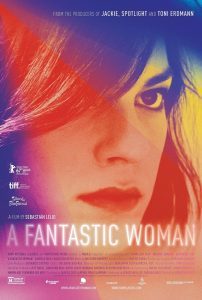
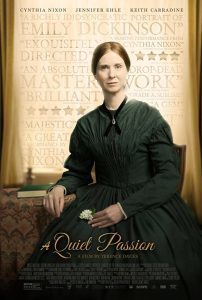

The post This Week in Movies with Meaning appeared first on Brent Marchant.
February 7, 2018
‘Bombshell’ dissects the sometimes-puzzling nature of beliefs and outcomes
“Bombshell: The Hedy Lamarr Story” (2017). Cast: Interviews: Hedy Lamarr, Fleming Meeks, Anthony Loder, Denise Loder-DeLuca, Lodi Loder, Peter Bogdanovich, Mel Brooks, Robert Osborne, Jennifer Hom, Diane Kruger, Michael Tilson Thomas, Jeanine Basinger. Archive Footage: Merv Griffin, Howard Hughes, John F. Kennedy, Clark Gable, Victor Mature, George Antheil. Director: Alexandra Dean. Screenplay: Alexandra Dean. Web site. Trailer.
To be blessed with great beauty is truly miraculous. To be gifted with a great mind is genuinely extraordinary. But to be the beneficiary of both is a dream beyond measure – or at least that’s what most of us probably believe. As it turns out, though, that belief may not be as true as we might think, a conundrum brought to light in the informative new documentary, “Bombshell: The Hedy Lamarr Story.”
In the 1930s, ʼ40s and ʼ50s, actress Hedy Lamarr (1914-2000) was arguably the most beautiful woman in Hollywood. In the years before World War II, the Jewish Austrian émigré fled her homeland and made her way to the U.S., where she rocketed to stardom as one of the biggest names in motion pictures, appearing in such films as “Algiers” (1938), “Boom Town” (1940), “Ziegfeld Girl” (1941) and “Samson and Delilah” (1949). She also became the standard of glamour after which many other aspiring actresses patterned themselves. Her iconic looks even inspired the appearance of such fictional characters as Snow White and Cat Woman.
But there was more to Lamarr than just a pretty face. She also had quite a mind for science, something she eagerly developed while in grade school in Austria. Despite no formal training, she had a robust curiosity and a natural knack for determining how things work and how things could be made to work to fulfill particular purposes. And, even though she was probably best known for her on-screen work, she quietly developed a respected reputation among scientists and inventors who became aware of her insights and abilities. For instance, she befriended aviation industrialist Howard Hughes, helping him with fashioning the wings for his new jet technology, an inspiration that came to her by simply observing the angular wing and fin shapes of fast-flying birds and fast-swimming fish and applying the concept to aircraft design. Her ideas thus helped Hughes overcome a fundamental design issue that his own team of engineers was previously unable to solve.

Iconic looks made actress Hedy Lamarr the staple for aspiring actresses in Hollywood in the 1930s, ʼ40s and ʼ50s, as noted in the informative new documentary, “Bombshell: The Hedy Lamarr Story.” Photo © Diltz/RDA/Everett Collection (00523921), courtesy of Zeitgeist Films.
However, Lamarr’s greatest scientific accomplishment came about as a result of something more near and dear to her own heart. As World War II ramped up, German U-boats sank Allied vessels virtually at will, and their targets included not only warships, but also transport craft ferrying refugees to freedom. With so many dying at sea, Lamarr believed something had to be done to stop the carnage, especially since she had relatives who were similarly looking to escape Europe and the tyranny of the Third Reich.
Lamarr was interested in developing measures to counteract the German U-boats, specifically technology to undermine the submarines’ jamming capabilities for sending Allied radio-controlled torpedoes off course, missing their targets. Working with her friend George Antheil, a composer and pianist well acquainted with player piano mechanics, Lamarr developed a frequency hopping system that would enable the torpedoes from being jammed or detected, allowing them to reach their German targets. For their efforts, the duo received a patent, one in which the U.S. Navy initially expressed interest but eventually dismissed for technical implementation issues. Despite this disappointment, Lamarr still wanted to do her part to aid the American war effort, seeking to join the National Inventors Council, but she was instead told that she could do more for the country by conducting rallies to sell war bonds. Her looks, it seems, were deemed a more effective weapon than anything she could develop technologically.
Years later, however, Lamarr’s invention was rediscovered by tech pioneers who successfully used it in developing military defense applications and as the basis for creating secure WiFi, GPS and Blue Tooth devices. Unfortunately, Lamarr received no compensation for her discovery, and, due to a statute of limitations issue, she was unable to sue for patent infringement. That cost her greatly, given that experts estimate the technology’s application value at upwards of $30 billion.
With her looks and movie career fading with age, Lamarr began to live a more secluded life. It was also a time when she began experiencing a variety of other issues. She lost a fortune trying to launch her own film production company (a rarity for a woman in those days), largely because she struggled with locating distributors for her movies. In an attempt to revive her career, she became preoccupied with plastic surgery, but the procedures often did more harm than good. What’s more, she wrestled with a meth amphetamine addiction, a problem that led to behavioral issues, including several scandalous arrests for shoplifting despite having large stashes of cash in her possession at the time. And, on top of all that, she became embroiled in several high-profile lawsuits involving the publication of her autobiography and with filmmaker Mel Brooks over the use of a variation of her name in the bawdy Old West comedy “Blazing Saddles” (1974).

A “star” in the truest sense of the word, actress and inventor Hedy Lamarr, as seen here in “Ziegfield Girl” (1941), possessed both iconic beauty and great intellect, as detailed in documentary filmmaker Alexandra Dean’s latest offering, “Bombshell: The Hedy Lamarr Story.” Photo courtesy of Zeitgeist Films.
As Lamarr sank deeper into her seclusion, details about her life – particularly her scientific endeavors – were becoming lost to history. However, in 2016, filmmaker Alexandra Dean came across never-before-heard audio tape interviews with Lamarr conducted by Forbes magazine journalist Fleming Meeks. Through those tapes, Lamarr’s life comes alive, including details about her largely unknown technological accomplishments. An undiscovered multidimensional persona thus emerges but one about which Lamarr herself laments a woman of her day could have beauty or brains but not both.
From the foregoing, one could rightly say that Lamarr’s life was a study in contrasts – someone who was capable of coming up with tremendous accomplishments but who also fell victim to many disappointments. It’s enough to cause one to wonder how she could be so inventive and ingenious, on the one hand, yet so prone to setbacks and letdowns, on the other. Why such a pronounced discrepancy?
A clear-cut answer to that question may never emerge. But, from a metaphysical standpoint, the workings of the conscious creation process may help to shed some light on things. Based on the notion that our thoughts, beliefs and intents shape the manifested existence we experience, conscious creation maintains that our reality is a reflection of those intangible building blocks, leading to the materialization of a world embodying those metaphysical cornerstones. And, if we were to apply that idea to Lamarr’s experience, it would seem that her life sprang forth from a collection of conflicted beliefs.
For instance, as noted above, Lamarr observed that women of her day could have beauty or brains but not both. The implication here is that they would have to choose one or the other. Yet Lamarr successfully created both for herself, which raises the question, why would she manifest an outcome contrary to a fundamental belief? Such a contradiction, regrettably, tends to doom the creator to failure, since both results can’t exist simultaneously. By being forced into making a choice, Lamarr had to give up on one of her creations – despite her success at being able to materialize both – in light of her overriding contention about what women could “realistically” achieve for themselves.
In many ways, this pattern tended to repeat itself in other areas of her life, reflecting an ability to draw in what she wanted but not being able to make it work. For instance, Lamarr had no trouble attracting men into her life. In fact, she was so successful at it that she married six times. The implication here, however, was that she could find but could not sustain romantic relationships in her life. The same was true of her experience as a businesswoman, having successfully launched a film production company but not being able to make a go of it over the long term. And, when she sought to revive her career by having plastic surgery, she even managed to come up with ideas for some innovative procedural techniques that have been used ever since, despite the fact that they didn’t work in her case.
And then, of course, there were Lamarr’s many technological innovations. The ideas for them came to her quite effortlessly, as if flowing in on an unfettered stream of consciousness and uninhibited intuition. But, when it came to putting those creations into use, stumbling blocks appeared at seemingly every turn. Again, she could draw to her what she envisioned but had trouble making it work once the idea transformed from an intangible concept into a corporeal manifestation.
Conundrums like this naturally raise the question, why did she do things in this way? Isn’t this a recipe for disappointment and disillusionment? One might easily say yes. However, there could be other belief considerations to bear in mind.
For example, when it came to Lamarr’s development of the frequency hopping technology, she was inspired by strongly felt personal considerations, namely, sparing the lives of innocent victims and military personnel at the hands of Axis forces. And, as events played out, the idea for the invention came to her comparatively easily. In conscious creation terms, this is an expression of Lamarr practicing her value fulfillment, the principle of us being our best, truest selves for the benefit of ourselves and others. When we tap into our value fulfillment, drawing upon our sense of personal integrity, materializations in line with these concepts tend to arise with relative ease. And, because value fulfillment urges us to further the cause of this kind of unencumbered altruism, we often proceed in acting without concern for ancillary considerations, such as those related to personal gain (or even potentially conflicting beliefs). All of which may help to explain why Lamarr never benefited financially from her technology; she did the right thing in developing it, regardless of whatever else might have come from it – positively or negatively – including any compensation that would have been due her.
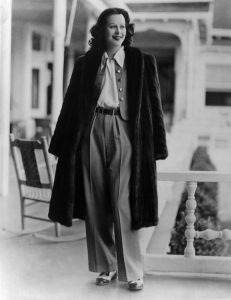
It took more than wearing pants for actress and inventor Hedy Lamarr to get noticed in a man’s world, as noted in the insightful new documentary, “Bombshell: The Hedy Lamarr Story.” Photo courtesy of Zeitgeist Films.
However, were these outcomes inevitable? Not necessarily. Given that conscious creation maintains we have access to an infinite number of manifestation possibilities at any moment, we can conceivably materialize anything we wish as long as we have adequate belief support behind such initiatives. Lamarr could have chosen a different result if she had maintained different underlying beliefs. But, considering the prevailing cultural beliefs at the time (i.e., most notably that she lived “in a man’s world”), the impact of such notions most likely undercut any alternative intents that she may have attempted to formulate, thereby leading to the results she experienced. Truly unfortunate.
By the same token, Lamarr’s experience may have also served to draw attention to the kinds of regrettable disparities she and other women endured. What’s more, a film like “Bombshell” helps to shine a bright light on such once-prevalent inequities, providing viewers with an excellent example of a woman who was indeed capable of succeeding in more than one arena. In that sense, then, Lamarr may have been a role model without being fully aware of it, showing us possibilities that may not have been available in her day but that are certainly entirely feasible now.
It’s unclear if Lamarr ever heard of conscious creation, but, considering how insightful she was, she may have had an awareness (even if only subconsciously) of it or something like it. Given her remarkable prescience in so many ways, her actions and accomplishments reveal someone who had mastery over many of conscious creation’s fundamental principles, even if she wasn’t overtly aware of them or knew what they were called. Those seeking to live up to their potential can draw upon her successes as a source of inspiration in becoming all they hope to be.

“Bombshell” brings forth Lamarr’s many sides – including the triumphs, the missteps, the successes and the downfalls – through her own words, as well as those of her family, friends and journalist Fleming Meeks and those of film industry and scientific experts who have studied her life and work. The documentary effectively combines these conversations with clips from Lamarr’s movies and historical footage and photos from her personal and public life. In doing all this, director Dean gives viewers an insightful look into the life of a Hollywood legend who had talents far beyond her acting ability and intellectual attributes equal to her iconic beauty, most of which were unknown, overlooked or downplayed by a society not ready to accept a woman who possessed both qualities. This film thus does justice to someone for whom such accolades often eluded her during her own lifetime.
Lamarr’s story essentially details what it means to struggle for recognition of our abilities in a world that, unfortunately, is often all too unable or unwilling to recognize them for what they are. It’s gratifying to see efforts like this that help to make up for those oversights and, one would hope, that we don’t make the same mistake again.
Copyright © 2018, by Brent Marchant. All rights reserved.
The post ‘Bombshell’ dissects the sometimes-puzzling nature of beliefs and outcomes appeared first on Brent Marchant.
Tune in for The Cinema Scribe
Tune in for the latest Cinema Scribe segment on Bring Me 2 Life Radio, Wednesday, February 7, at 12:45 pm ET, by clicking here. And, if you don’t hear it live, catch it later on demand!

The post Tune in for The Cinema Scribe appeared first on Brent Marchant.
February 6, 2018
This Week in Movies with Meaning
Reviews of “Bombshell: The Hedy Lamarr Story” and “In the Fade,” as well as a podcast preview, are all in the latest Movies with Meaning post on the web site of The Good Media Network, available by clicking here.

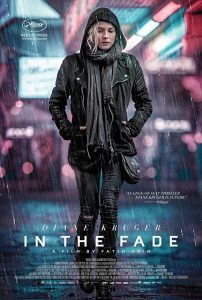



The post This Week in Movies with Meaning appeared first on Brent Marchant.
January 31, 2018
‘Film Stars’ probes the depth and truth of love
“Film Stars Don’t Die in Liverpool” (2017). Cast: Annette Bening, Jamie Bell, Julie Walters, Vanessa Redgrave, Kenneth Cranham, Stephen Graham, Frances Barber, Leanne Best. Director: Paul McGuigan. Screenplay: Matt Greenhalgh. Book: Peter Turner, Film Stars Don’t Die in Liverpool. Web site. Trailer.
Falling in love is undoubtedly one of the greatest joys of life. The passion, fulfillment and bliss that come from it are indescribable and beyond compare. Unfortunately, when it goes wrong or becomes burdened by extenuating circumstances, it can have a debilitating, painful downside. Those ups and downs are the subject matter of the new, fact-based romance, “Film Stars Don’t Die in Liverpool.”

Fading film star Gloria Grahame (Annette Bening) takes to the stage to prop up her sagging career in the new, fact-based romantic drama, “Film Stars Don’t Die in Liverpool.” Photo by Susie Allnutt, courtesy of Sony Pictures Classics.
In 1978 London, aspiring actor Peter Turner (Jamie Bell) had a passing encounter with his new neighbor, Academy Award-winning actress Gloria Grahame (Annette Bening), an aging film star who had fallen out of favor in recent years. Grahame, a vampish blonde starlet who earned a reputation for playing “bad girls,” made a name for herself as the flirtatious Violet Bick in Frank Capra’s “It’s a Wonderful Life” (1946) and won an Oscar for her performance in “The Bad and the Beautiful” (1952). However, over time, with age, fading looks and the rising popularity of screen competitors like Marilyn Monroe, Gloria’s star gradually declined. She also developed a reputation for being somewhat difficult to work with, all of which caused her to be relegated to more obscure roles. She took whatever parts she could get on stage, screen and TV, both in Europe and America.
Off-screen, Gloria’s persona in many ways echoed her movie presence, and, when she met Peter, she turned on the charm with him in much the same way her characters did with their romantic prospects. Despite their vast difference in age – she was 54, he was 28 – there was an undeniable chemistry between them, a bond that quickly birthed a torrid relationship. But, as became apparent over time, the romance was driven by more than just hormones; Gloria and Peter truly were in love.

Despite an age difference of 20+ years, onetime screen idol Gloria Grahame (Annette Bening, left) and aspiring actor Peter Turner (Jamie Bell, right) find love in “Film Stars Don’t Die in Liverpool.” Photo by Susie Allnutt, courtesy of Sony Pictures Classics.
However, as much as Peter adored Gloria (and vice versa), the couple also had its problems. Gloria’s increasing obsession with her looks, her denial about her advancing age and her efforts at keeping a lid on secrets from her past all caused her to be capricious and temperamental. She also held on to her share of unrealistic expectations, such as a hope that she would one day be cast to play the role of Juliet in Shakespeare’s famous romantic tragedy, a disappointment waiting to happen that would assuredly lead to tantrums, pouting and despair. Peter often attempted to comfort his beloved in these situations, but he often became the unwitting target of her wrath, frustration and sarcasm. And, as new and even bigger challenges began affecting Gloria, the strain between them grew progressively worse. But, despite indications to the contrary, when the real reasons behind Gloria’s behavior became apparent, it was obvious that she loved Peter more than he or anyone knew, a fact that was buried under some odd covering and something that remained hidden until circumstances became dire.
It’s unfortunate that the depth of our feelings often isn’t revealed until we find ourselves in crisis, as was the case with Peter and Gloria. Of course, it’s not realistic to expect that to change as long as we’re mired in denial about our circumstances. Having the courage to face the truth about ourselves and our emotions can help us break through such obstacles, making it possible for us to find out what it means to truly be in love – and to express it freely to those we care about.
Such circumstances and attitudes are a direct outgrowth of our thoughts, beliefs and intents, the building blocks of the conscious creation process, the means by which we each manifest the reality we experience. And that existence will invariably faithfully reflect the nature of those thoughts, beliefs and intents, for better or worse, whether we like it or not.

Aspiring actor Peter Turner (Jamie Bell) falls hard for a faded screen idol in the new romantic drama, “Film Stars Don’t Die in Liverpool.” Photo by Susie Allnutt, courtesy of Sony Pictures Classics.
It’s hard to say if Gloria was aware of any of this, but, as the film illustrates, her reality indeed mirrored the beliefs she held. Try as she might to squelch things about herself, her life and her past, those influences lingered in the makeup of her existence, ever looming and threatening to emerge when they could no longer remain hidden under the weight of containment. But, rather than own up to them and acknowledge their presence, Gloria would generally struggle to hide or minimize them, even from those who cared about her, like her adoring Peter and his kindly parents (Julie Walters, Kenneth Cranham), who freely treated her like one of the family. Instead of accepting the help and compassion they showed her, Gloria sometimes pushed them away in apparent acts of ingratitude.
But were Gloria’s actions truly thankless? Superficially speaking, that would seem to be the case. Upon further scrutiny, however, there was more to her behavior than met the eye. Those who looked closely enough might be able to see what her real motivations were. But, to do that, onlookers would need to make use of their powers of discernment to be able to see what was truly going on. This would require them to strip away the camouflage that obscured their perceptions and perspectives, a practice that, for example, called upon them to distinguish the person from the characters she was known for playing – something that might not have been easy to do but that would reveal significant distinctions, despite the superficially similar trappings that characterized the two. Those who succeeded at this would undoubtedly see a very different picture, one depicting the real Gloria, someone who was not her screen presence, even if it often seemed that way.
Making distinctions like this is a lesson we could all learn from. Failure to do so often results in misunderstandings, frequently with painful or frustrating consequences. Were we to do that, we could spare ourselves considerable hardship, enabling us to get the most out of our relationships and circumstances, unburdened by the anxiety and heartache that come from misinterpretations, a crucial consideration when we’re faced with situations in which we may not have much time to act.

Caring, compassionate Bella Turner (Julie Walters) treats a celebrity guest in her home like one of the family in the touching, new, fact-based romance, “Film Stars Don’t Die in Liverpool.” Photo by Susie Allnutt, courtesy of Sony Pictures Classics.
This vastly underrated cinematic gem definitely deserves wider attention – and far more appreciation – than it has received. With what is arguably Bening’s best screen performance, coupled with a fine counterpart lead portrayal by Bell, this heartfelt romantic tearjerker justifiably earns every bit of emotion it evokes from audiences. It also features one of the best original songs to grace the screen in ages, Elvis Costello’s fittingly moving You Shouldn’t Look at Me That Way. If you enjoy good old-fashioned love stories, go see this one, despite what the cynics might say (but keep the tissues handy).
“Film Stars Don’t Die in Liverpool,” unfortunately, has not received the awards season recognition it deserves. Thankfully, though, the BAFTA Awards – the British equivalent of the Oscars – came through to help make up for this, honoring the picture with nominations for best actress (Bening), actor (Bell) and adapted screenplay. It would have been gratifying to see this offering pick up additional accolades, but at least these three nods are better than nothing (which really would have been a shame).
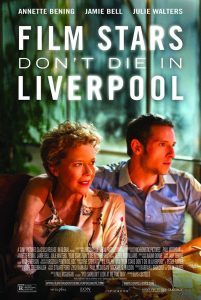
Our time on this planet is shorter than most of us tend to realize, and it would be in our best interests to make the most of it while we have the chance, especially where love is concerned. Gloria and Peter bring that truth front and center, shining a brilliant light on it to help us appreciate its veracity and significance. Let’s hope we’re paying attention.
Copyright © 2018, by Brent Marchant. All rights reserved.
The post ‘Film Stars’ probes the depth and truth of love appeared first on Brent Marchant.
January 30, 2018
‘Molly’s Game’ wrestles with what drives our motivations
“Molly’s Game” (2017). Cast: Jessica Chastain, Idris Elba, Kevin Costner, Michael Cera, Jeremy Strong, Chris O’Dowd, J.C. MacKenzie, Brian d’Arcy James, Bill Camp, Graham Greene, Claire Rankin, Samantha Isler, Piper Howell. Director: Aaron Sorkin. Screenplay: Aaron Sorkin. Book: Molly Bloom, Molly’s Game: From Hollywood’s Elite to Wall Street’s Billionaire Boys Club, My High-Stakes Adventure in the World of Underground Poker. Web site. Trailer.
The motivations that drive our actions are usually clear, but sometimes they may stubbornly elude us, so much so that, after a while, we might not wonder (or even care) what they are. This often happens when we get caught up in circumstances in which we lose sight of how we got there and don’t know how to extricate ourselves. And, by then, we may find ourselves on a treadmill from which there is no apparent escape. So it was for an Olympic hopeful whose career came to an abrupt end, forcing her to change directions and embark on a journey she never expected, as detailed in the new, fact-based drama, “Molly’s Game.”
After years of intensive training as a freestyle skier, Olympic hopeful Molly Bloom (Jessica Chastain) sought to secure a spot on the U.S. squad for the 2002 Winter Games in Salt Lake City. Through the years, Molly’s demanding father, Larry (Kevin Costner), pushed her hard to become a champion, first as a child (Piper Howell) and later as a teen (Samantha Isler). In some ways, Molly resented the relentlessly rigorous training, but it also imbued her with an undeniable drive for success, one that helped her defy the odds and overcome a near career-ending injury in her teens. And, by the time she made her Olympic bid, she seemed poised for a date with destiny – save for a traumatic fall during competition that knocked her out of the running and off of the slopes for good.

Onetime Olympic hopeful-turned-poker game operator Molly Bloom (Jessica Chastain, right) consults her high-powered lawyer, Charlie Jaffey (Idris Elba, left), when she finds herself in hot water in writer-director Aaron Sorkin’s latest offering, “Molly’s Game.” Photo by Michael Gibson, Motion Picture Artwork, courtesy © STX Financing, LLC.
Fortunately for Molly, she had a backup plan … sort of. As a bright, educated college graduate, she possessed the intellect to become a success in virtually any field she chose. Unfortunately, she lacked direction and wasn’t sure what she wanted to do. She contemplated attending law school but instead chose to move to Los Angeles for a year to find her focus, a decision that infuriated her father. Nevertheless, Molly headed to California in search of whatever life had in store for her.
Molly initially took a job as a waitress in an upscale Los Angeles nightclub, one frequented by big-tipping celebrities and high rollers. While working there, she met Dean Keith (Jeremy Strong), an obnoxious but extravagant real estate developer who offered her a position as his office manager. In no time, Molly became a key player in Dean’s organization, including as operator of his high-stakes underground poker game, a contest that regularly attracted professional athletes, investment bankers and movie stars, most notably the infamous Player X (Michael Cera), a well-known but unidentified Hollywood actor. Although Molly knew virtually nothing about the game at the outset, she learned quickly, hauling in huge tips from the players for her efforts as the event’s attentive hostess. She became so successful, in fact, that Dean felt threatened by her, eventually firing her. But, with the contacts she made through Dean’s game, Molly was soon able to set up an operation of her own, one that was set in a more lavish setting – and with even bigger stakes.
Over time, Molly’s success blossomed as the ranks of her game’s high rollers swelled. But, given the unsavory nature of some of the players, she soon fell prey to the questionable activities of some of her regulars. Almost overnight, her astounding success evaporated, prompting her to relocate her operation from Los Angeles to New York, a move designed to cash in on the potential fortune to be made from the city’s wealthy voracious gamblers. Before long, however, Molly found herself in the company of a cabal of even shadier characters, including members of the Russian mafia and Italian mobsters seeking to horn in on her operation. What’s more, to keep going under the mounting pressure, Molly propped herself up with an array of pharmaceuticals, a move that increasingly eroded her perspective. Clearly it was time to get out. But how?
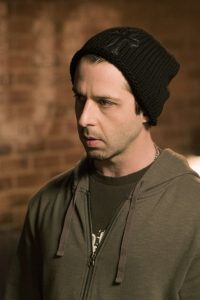
Real estate developer Dean Keith (Jeremy Strong) has an interesting proposition for one of his employees in the new, high-stakes drama, “Molly’s Game.” Photo by Michael Gibson, Motion Picture Artwork, courtesy © STX Financing, LLC.
The answer came in the form of an FBI raid. With all of her assets seized, Molly moved home with her mother (Claire Rankin) and wrote a book about her experiences. Under the impression that the worst was behind her, Molly sought to move on with her life – that is, until she was arrested again, charged with running illegal gaming activities, specifically the operations that were shut down two years previously during the initial FBI raid. And so, faced with severe penalties and long jail time, she hired a high-powered lawyer, Charlie Jaffey (Idris Elba), to help her get out for good as unscathed as possible.
To find her way clear, however, Molly needed to get serious about how she ended up in this situation. That meant more than figuring out how she came to know such colorful characters as card sharp Harlan Eustice (Bill Camp), Ponzi scheme operator Bad Brad (Brian d’Arcy James) and Russian mob go-between Douglas Downey (Chris O’Dowd); it meant facing up to the reasons – the real reasons – why she pursued this course in the first place. And that meant getting in touch with those ever-elusive motivations. She needed to address what it meant to be the Molly she had become – and why – perhaps for the first time ever.
In circumstances like this, it’s far too easy to just shrug our shoulders and say “Things just happen.” But such attitudes are all too convenient and the height of irresponsibility. There are reasons behind our behavior, and getting to the bottom of them is key to understanding them, especially if we’re wrapped up in questionable activities that we hope to get past and never repeat again.
This is where the importance of our awareness of the conscious creation process comes into play, for it sheds light on how and why our reality emerges as it does through the power of our thoughts, beliefs and intents. It helps us to understand our motivations and how they lead to the existence we experience, for better or worse. That’s the challenge put to Molly as she works her way through her personal odyssey.

High-rolling gambler Player X (Michael Cera) quickly becomes a regular in a high-stakes poker game operated by a onetime Olympic hopeful in the new, fact-based drama, “Molly’s Game.” Photo by Michael Gibson, Motion Picture Artwork, courtesy © STX Financing, LLC.

Card sharp Harlan Eustice (Bill Camp) savors the thrill of the game when it comes to high-stakes poker in “Molly’s Game.” Photo by Michael Gibson, Motion Picture Artwork, courtesy © STX Financing, LLC.
As Molly’s story unfolds, it’s apparent that her motivations have little to do with running a gambling operation per se. But, if so, then what is the driving force behind her actions? That’s what she needs to discover. Yet, the more she becomes embroiled in her circumstances, the more she loses sight of where she is, how she got there and why. If she ever hopes to escape her situation, she needs to get serious about addressing such matters – and fast.
If Molly’s to uncover the reasons behind her actions, she needs to ask herself questions like what does she get out of these activities? What accomplishments can she lay claim to from them? Does the operation, its attributes or its participants provide clues as to why she’s involved in it? And, perhaps most importantly, how does running a game with such dangerous and seedy elements satisfy her needs?
As the film’s narrative plays out, clues answering these questions begin to emerge. However, ironically enough, the individual least able to recognize them is Molly herself. In part this is undoubtedly due to being so caught up in the day-to-day matters of the game that she can’t see her way clear; the proverbial forest for the trees metaphor comes to mind. But it’s also partly attributable to avoiding the aforementioned questions in the first place, be it unwittingly or intentionally. In Molly’s case, one could argue that she seems to be blissfully ignorant of her underlying motivations (and willingly so), either because they involve something in which she has no pressing interest or, more likely, because they relate to issues she’s unwilling or not ready to face.

Addressing the pain of the past is a key concern for onetime Olympic hopeful-turned-poker game operator Molly Bloom (Jessica Chastain, right) when confronting her demanding father, Larry (Kevin Costner, left), in writer-director Aaron Sorkin’s “Molly’s Game.” Photo by Motion Picture Artwork, courtesy © STX Financing, LLC.
In a situation like this, we’re nearly always forced into facing beliefs we don’t want to address, be it because we find them painful, embarrassing or otherwise uncomfortable. Yet, if we ever hope to get past them – both to rewrite them more to our liking and to generate a more amenable outcome – we must first confront them in their present form. As the heat gradually gets turned up on Molly, the means to make this happen start to arise. Like many of us, she may not enjoy having her hand called, but, if that’s what it takes, then that’s what must transpire if things are ever going to change.
If Molly is going to unravel her motivations, she needs to examine the beliefs that spawned them, particularly how those beliefs came into being. This means analyzing the intellectual and intuitional input that led to their formation. Taking that into consideration, Molly has the intellectual aspect covered; as a bright, scholarly sort, she’s perceptive, quick-witted and incisively attuned, as evidenced by how fast she learns the ropes of manifesting a successful high-stakes gambling operation, all the way down to the finest of nuances. However, intuitionally speaking, she needs to take off her blinders or, at the very least, sharpen her focus to pay attention to those significant, if seemingly irrational elements that play a role just as important as her intellect in belief formation and reality creation. If she were to do that, she’ll get her answers – and probably a lot quicker than she thinks possible.
On a cursory glance, one might be tempted to think that Molly’s inability or reluctance to identify her motivations has to do with the somewhat shady nature of her vocation, that she might not want to face the truth given the character of her work and her associates. But, counterintuitive though it might be, Molly actually has a strong ethical streak that runs through her, one driven by an apparent sense of integrity. She does her level-best to run an honest game, despite the questionable nature of the operation itself and the dubious nature of her colleagues. She also works hard to preserve the privacy of her clients, refusing to divulge names when offered plea deals and even protecting the identity of the aforementioned Player X.

Russian mob go-between Douglas Downey (Chris O’Dowd, right) connects high-stakes poker game operator Molly Bloom (Jessica Chastain, left) with questionable new players in the new fact-based drama, “Molly’s Game.” Photo by Michael Gibson, Motion Picture Artwork, courtesy © STX Financing, LLC.
Given the foregoing, then, Molly wouldn’t appear to have issues with qualities like honesty and integrity, something that she should apply to her treatment of herself as much as she does to that of others. So, once again, the gaming mistress is faced with the question of her apparent inability to assess her motivations for setting up and running her operation. It repeatedly raises the question, why won’t she do so?
When the truth behind those motivations is at last revealed, we may be shocked at what we see. In fact, her reasons would appear to have no discernible relation to their associated manifestations. Nevertheless, as the connection becomes clarified, it’s possible to see how and why her existence has materialized as it has, something we should bear in mind when it comes to understanding the nature of our own realities, no matter how seemingly incongruous the nexus between the motivations and manifestations may appear. It’s with this knowledge that we can then begin to reformulate our beliefs to create an existence more in line with our hopes, goals and desires. And so it is with Molly, too.
Given Molly’s obliviousness to her own motivations suggests that she likely has little awareness of the metaphysical process with which they’re associated. However, after going through a scenario like this, it’s a pretty safe bet that she’ll make more of an effort to keep it in mind going forward. It’s hard to ignore the lesson that comes from an experience as significant (and challenging) as this, and any of us who go through something comparable to this and attempt to downplay its impact do so at our own peril. Consider this a cautionary tale well worth taking to heart.

While much of “Molly’s Game” plays like a crime drama, the underlying issue, as discussed above, is finding oneself. This offering from writer and first-time director Aaron Sorkin spins an intriguing yarn about a one-of-a-kind character, and it does so by successfully maintaining a brisk pace for its 2:20 runtime. The film also serves up yet another sparkling performance by Chastain, who once again demonstrates her tremendous skill at being able to disappear into a role, delivering one of the best lead performances of 2017, an effort that earned her Golden Globe and Critics Choice Award nominations for best actress. Backing Chastain is a superb ensemble, especially Elba, Costner, Cera and Camp, all of whom deliver some of their best on-screen work. Though I would have preferred that the dialogue sounded a little more natural and a little less “written,” the picture nevertheless features a capably crafted script adaptation, one that pulled down Golden Globe, Critics Choice, BAFTA and Oscar nominations for best screenplay.
Stripping away the veneer to find out who we really are and what we’re really trying to accomplish may prove to be quite a taxing process. But, if we’re ever to get the answers we seek in these areas, sometimes we have to pause to assess our circumstances, taking time to stop, catch our breath, and give our thoughts, beliefs and intents a good, hard look. We might be surprised at what we see. We may not like it, either. But at least such evaluations are honest, and that’s as good a starting point as any to determine where we are – and where we want to go.
Copyright © 2018, by Brent Marchant. All rights reserved.
The post ‘Molly’s Game’ wrestles with what drives our motivations appeared first on Brent Marchant.



